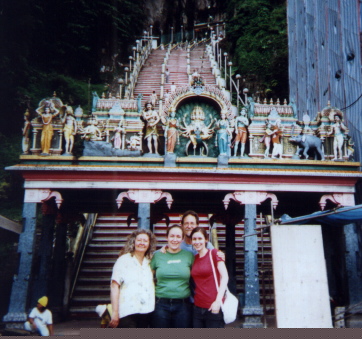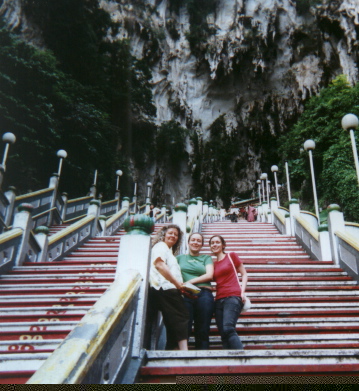Chapter 19: The Batu Caves
Our tour package: тАЬVisit the Batu caves, a sacred Hindu shrine. Climb 272 steps to reach the cool interior of the caves.тАЭ
WeтАЩve been to the Mayan pyramids in the Yucatan and the Khmer temples in Cambodia. In both cases the stone steps were steep and wet with moisture from tropical humidity. Further there were no guard rails. In both cases the guide had warned us: тАЬBe careful. Every year a few tourists die from falls because they slip on the wet surfaces. Remember this is not Disneyland.тАЭ Both of these were archaeological sites that were up to 1000 years old. Both of them were considered ruins. The civilizations that had spawned these magnificent architectural masterpieces were long gone.
I expected something similar at the Batu caves. Not.
We drove up to the entrance of the caves. A small fence barred our way. On the left was a building where we could purchases tickets for entry, which included an audio tour. Tickets in hand, the guard allowed us to pass through. Immediately in front of us was a large gateway adorned with ornate Hindu statuary. Although their were 272 steps which were counted in Arabic numerals at the base of each step, they were of normal size, i.e. not steep and narrow. Further there were guard rails and intermediate landings which provided additional security. While the Mayan and Khmer ruins were somewhat dangerous, these steps were tame.

And a little closer look at the statuary.

Passing through the gateway we were immediately overwhelmed by enormous caves which loomed above us. Irregular rock formations pulled our eyes upwards to the heavens, dwarfing everything man made. The natural splendor was awe-inspiring in and of itself. We climbed the many steps to reach the caves.

Along the climb there were many monkeys scurrying about looking for handouts.
Guide: тАЬBeware of your belongings, not from other humans, but from the monkeys. You might want to buy some peanuts for own protection.тАЭ

Even with this warning, an older monkey managed to steal a whole bag of peanuts from Laurie when she wasnтАЩt paying attention. Further Miranda, still recovering from nausea, took advantage of the monkey diversion to rest on the long climb to the top.
Although the Batu Caves had been considered sacred by the Malaysian Hindus for a long time, the actual shrine with statuary and stairs had been built relatively recently - in the late 1890s. Not what you would call ancient. It was financed by a wealthy Hindu businessmen as a place of worship. Evidently it has been successful because once a year tens of thousands Hindus congregate at the Batu Caves to worship together.
These were not the crumbling ruins of a dead culture. On the contrary the shrine was well maintained and a place of active religious devotion. Not an archeological site. It was evident that this a vital shrine as well as an tourist attraction and not an ancient temple.
The fellow, who initiated this shrine, was a descendant of the Tamils who came from the Indian state of Tamilnadu. These are the same Tamils who speak Dravidian and are thought to be the descendants of the Harrapan civilization who lived on the Indus River and migrated south when attacked by the Aryan invaders. These are the same Tamils who have had such a huge influence on the cultures of Southeast Asia.
After climbing the numbered steps we reached the cool interior of the wet caves. The word тАШcavesтАЩ is a slight misnomer, because looking up one could see the heavens. Although there were plenty of rock overhangs, the cloudy sky was constantly visible above the 100 feet high rock walls.

The first enormous enclosure had a series of 10 sets of statuary devoted to Lord Murugan. According to the audio guide each set of colorful life size sculptures was intended to illustrate a particular story in Lord MuruganтАЩs life. Evidently he, along with Ganesha, was one of ShivaтАЩs sons. Ganesha lost his head protecting his mother from Shiva, who didnтАЩt recognize him. Once the mistake was discovered, his head was replaced by that of an elephant. As the remover of obstacles Ganesha is one of the most popular Hindu gods. But this particular shrine was devoted to his brother, Murugan, the favorite god of the Tamils.
Lord Murugan is especially revered by the Tamil Indians. He is also called Lord Subramaniam and the 6 faced one, because his increased awareness allows him to face all directions. The worship of Lord Murugan is said to cure incurable diseases and restore vitality. When we were there they were in the process of constructing the largest stature of this god in the world.
Sprinkled in the commentary was the traditional Hindu philosophy illustrated by each story. One particular story was a sibling competition between the two. Their parents had a particularly succulent peach, which represented marriage. They said that the child who could go around the earth first could have it. Lord Murugan immediately sped off. The slow footed elephant headed Ganesha had no chance. Instead he circled around his parents, saying that they were his entire world. His devotion to his parents paid off as they awarded him with the peach of marriage.
Lord Murugan, on the other hand, was furious. He felt that he was a victim of trickery. However, instead of plotting revenge, he became a Yogi, a Hindu ascetic, going up into the mountain to practice austerities and meditation. Instead of assigning external blame, he attempted to put out the internal fire - hopefully to realize that the external is all an illusion. This was all illustrated in the final tableau of colorfully painted figures.
The Annual Festival
At the annual full moon festival in about late January, Tamils from all over the world come to worship Hindu style. This means that many of the devotees expect to enter a state of religious frenzy during this rite, quite unlike the more reserved Buddhist style of worship of the Thai or the Chinese. The festival is meant to commemorate ShivaтАЩs ecstatic dance with his consort Uma which created the Universe. On this day Lord Murugan was also given his spear, with which to slay the demons of illusion.
The festival can last from four days to a month. The active participants are expected to fast at certain times and eat only vegetarian food, when they do. Those involved in the complete program are also meant to be in seclusion from any but those that are involved in the same purification rites. The entire ceremony is meant to induce the state of ananda, i.e. divine bliss, in the devotees.
Part of the ritual includes attaching little vessels filled with milk onto the chest, which has been pierced by little silver hooks. Blood is not supposed to be spilled when these hooks are attached at the beginning of the ceremony or removed at the end. Further the representative of Lord Murugan on earth rides a chariot drawn by bulls from Kuala Lumpur to the Batu caves at the beginning and then returns at the end. He stops whenever he encounters his devotees. This celebration is not quiet and reserved like going to Anglo Protestant churches in America but based upon the inducement of ecstasy due to the proximity of Lord Murugan.
More Ramayana
The second cave or enclosure was devoted to botany, while the third was another set of statues devoted to, you guessed it, the Ramayana. We didnтАЩt have enough time to spend there, as the other members of our tour were ready to worship at the shrine of materialism, shopping, and we had spent too much time feeding the monkeys.
After we had returned to our guide bus;
Me: тАЬIs the Ramayana very popular with the Hindus of Malaysia.тАЭ
Danna: тАЬVery.тАЭ
Me: тАЬWith Hanuman, the monkey king, and Sita, RamaтАЩs beloved.тАЭ
Danna: тАЬYes, of course. We all know the story very well.тАЭ
Me: тАЬHow about the Bhagavagita?тАЭ
Danna: тАЬMuch less so.тАЭ
Me: тАЬThe Ramayana is more popular?тАЭ
Danna: тАЬBy far. The Bhagavagita is more for scholars and philosophers. The Ramayana is for the people.тАЭ
Wherever we look in Southeast Asia we find the Ramayana. Although both Cambodia and Thailand are entirely Buddhist, the Ramayana plays a prominent part in their popular mythologies and representations even though the story comes from Hinduism. This just indicates the huge influence that Hindu culture has had and has on the culture of Southeast Asia.
Danna: тАЬEach country, whether Thailand or Cambodia, has their own version of the Ramayana, but the Indian version is the only complete version.тАЭ
Me: тАЬEven China has their own version. ItтАЩs called the Journey to the West. The Chinese deny any connection, of course. But I feel the parallels are undeniable. Rama is a Buddhist monk called Tripitaka, while Hanuman is the mischievous, but powerful, Monkey, who represents the mind.тАЭ
Danna: тАЬWeтАЩll see this monkey on the way out.тАЭ
Leaving the Batu Caves we saw a huge statue of the honorable Hanuman, the Monkey King - not the devilish Chinese Monkey.
Me: тАЬI hope to meet my monkey, someday. But thatтАЩs not him.тАЭ
Monkey, aside: тАЬIt will be sooner than you think.тАЭ
While the Batu caves are not ancient ruins, they were a refreshing change from the Genting Highlands, dominated by international pop culture.